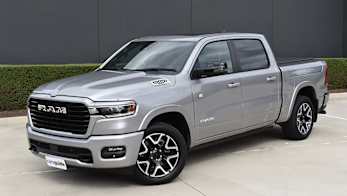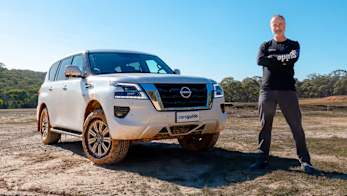Finally, you can touch it, smell it, taste it. Yep, the Kia Tasman is here on Australian shores.
Well, almost. You won’t be able to get your hands on a production car until July this year, but in anticipation of its momentous launch, Kia has granted us a preview of a top-spec (slightly) pre-production X-Pro in what it intends to be its natural environment: off road.
Has the wait been worth it? Does the Tasman really have the chops to take on established rivals, like the Toyota HiLux GR-Sport, Isuzu D-Max X-Terrain, or Ford Ranger Wildtrak?
Let’s find out.
Price and features – Does it represent good value for the price? What features does it come with? 7/10
7 / 10
We may be driving pre-production examples of the top-spec X-Pro specifically for this test, but we already know price-tags for the whole Tasman range. In bad news for those hoping for a cut-price bargain as Kia chases a slice of the market, you’ll be disappointed.
Instead, the Tasman starts higher than many of its rivals. An entry level S for example, starts at $42,990 before on-roads, making it some six grand more than equivalents.
The better news is by the time you get to the top of the tree, the X-Pro is closer to (but generally slightly more expensive than) its popular rivals.
.jpg)
Starting at $74,990 before going crazy on accessories (of which, Kia will have a few ready for launch) it’s certainly not a cheap option, and yes, there’s nothing particularly special about its 2.2-litre turbo-diesel engine which is notably more compact than Ford’s 3.0-litre diesel V6 or Isuzu’s 3.0-litre four-cylinder, but we’ll touch on this more later.
Instead Kia is hoping the Tasman X-Pro’s imposing dimensions, off-road capability, Australian-specific tuning, and modern sensibilities will set it apart.
This top grade comes with the usual luxuries of a top-spec ute. Items like synthetic leather interior trim with heated front seats, rear privacy glass, surround-view parking cameras, and a sunroof are par-for-the-course, but Kia moves things into luxury SUV territory with the addition of things like ventilation for the front seats, a heated steering wheel, and even heated seats for the two main rear positions.
.jpg)
What might impress off-road buyers more is the mechanical differences between this X-Pro grade and the rest of the range. The wheels are downsized to 17-inches from 18s on the X-Line grade below, featuring a specific large-diameter Hankook all-terrain tyre. This combines with additional spring height in the suspension to make for formidable clearance figures (more on this later) as well as an additional ‘Rock’ driving mode and X-Trek off-road cruise control feature.
Finally, the X-Pro also gets an off-road screen for the multimedia suite, which shows an array of useful data, like tyre pressures, steering angle, oil pressure, radiator temperatures, and also an off-road camera page for better wheel placement.
It’s a lot of additional fruit for off-road adventurers. Not to mention the Tasman also features a built-in factory trailer brake controller, with drivers able to enter the details of their trailer into the multimedia system, which then adjusts the transmission mapping to account for the size and weight of whatever you’re pulling. Clever.
.jpg)
It also all feels a bit more modern. The cabin has all the trimmings and feel of a modern SUV, and even the driveline can be placed in 4A mode, allowing four-wheel drive to be engaged automatically in low-traction scenarios, even when travelling at higher speeds. Not a feature present on all of the Tasman’s rivals.
Design – Is there anything interesting about its design? 8/10
8 / 10
No ute has had a more controversial design in recent years than the Tasman. With the Japanese utes, you’re mostly getting exactly what you expect. Current iterations of the HiLux, D-Max, and even new Triton have hardly caused a stir in the market, while new-age Chinese rivals seem to be pushing the envelope with more modern or grandiose designs, like the BYD Shark 6 or GWM Cannon Alpha respectively.
The Ranger seems to be more universally loved, blending the more compact dimensions of Australia and Thailand’s dual-cab tradition with the strong styling elements brought across from America.
Meanwhile the Tasman has forums, Facebook pages and buyers in disarray. Some think it looks tough, others have described it as ‘hideous’.
.jpg)
I was hoping seeing it in the metal would help settle my mind on it, but it hasn’t. If anything I feel more conflicted than before. For what it’s worth I don’t think ‘ugly’ is the right word to describe it. It’s just different.
Looking different can be an asset. It’s not derivative, and it doesn’t try to be overtly retro, instead it carves its own path with its big moustache panel which frames a blocky grille, and its weirdly small headlights. I think the whole thing looks like some sort of military surplus truck more than anything else.
One thing that's definitely communicated in the metal is its sheer dimensions. While not a full size up from the traditional Thai-built ute crop, the Tasman is longer than the Ranger, HiLux, and D-Max, at 5410mm, but the X-Pro at least also offers more ground clearance, with its wheelbase matching the Ranger.
.jpg)
Now the Tasman’s design has been out there for a while: Is it working for you or not? Tell us in the comments below.
Practicality – How practical is its space and tech inside? 9/10
9 / 10
The Tasman’s cabin feels big, and a lot of thought has gone into it, even from a local perspective. For example, the brand told us even the shape of the seats had been benchmarked against its key Australian rivals, with the final design aiming to beat the surprisingly comfortable D-Max. In addition, the centre console has some neat touches.
Yes, it has a big storage bay up front with dual wireless chargers, but it also gets a centre console box which opens up backwards and folds out into a tray to make for a temporary workspace.
Other clever touches are a mottled finish to the hard plastics, to make it harder to spot scratches, and the Tasman’s dimensions etched into the centre console, so you’ll always know if you’ll fit into the car park.
.jpg)
Storage comes via a huge pocket in each door with a bottle holder, two enormous bottle holders in the centre console with variable edges, and the armrest console box itself, which also houses a 12v outlet to add to the dual USB-Cs up front.
Headroom is stellar in the front two positions, and adjustability is nice too, courtesy of the eight-way adjustable seat and telescopically adjustable steering wheel.
It may have a more modern cabin layout than most utes with dual 12.3-inch screens, but the Tasman also features a dial for volume and toggles for temperature and fan speed, with some shortcut touch buttons too, to add to the functions available through the screen.
.jpg)
It might not be the hardest wearing cabin I’ve ever seen, but it’s well thought out, comfortable, modern and spacious.
The back seat offers enough room for someone my height (182cm) behind my own driving position. I get enough knee room and headroom despite a slightly lower roof to accommodate the sunroof present on this X-Pro grade.
Even the middle position seems somewhat useful thanks to an almost flat floor.
.jpg)
It has some neat features I haven’t seen before, like neoprene-clad storage pockets with a zipper, making them effectively waterproof, and about the size of an iPad. There are a further two small pockets up the top of the seats in front too.
USB-C ports feature on the side of each front seat, as does a full-size household power outlet on the back of the centre console underneath the dual adjustable air vents.
There’s plenty of storage available under the seats with the bases lifted, and the rear seats themselves are on rails, allowing a recline for rear passengers at the cost of knee room.
The height of the cabin is something to consider, however, it’s a big step up into it.
The tray measures 1511mm long, 540mm deep, and 1572mm wide, making it very competitive for the segment, and able to accommodate either an Australian or Euro-spec pallet. In addition it comes standard with a soft-open tailgate (which locks), a rail mounting system on both sides, LED lighting, and a full-size power outlet.
Small bonus features include a side-step built into the bumper, and on high-grade versions like this, a storage bay built into the fender flare over the wheel arch, which also locks with the car and features a weatherproof gasket.
Under the bonnet – What are the key stats for its engine and transmission? 7/10
7 / 10
Perhaps the second most controversial element of the Tasman after its styling is its choice of engine.
Sourced from the Korean brand’s passenger car range, the 2.2-litre four-cylinder diesel produces 154kW/440Nm. Despite the fact people will already write this engine off due to its size, the outputs have it equalling Toyota’s 2.8L engine and exceeding Isuzu’s 3.0-litre engine on power, while falling shy of most of its rivals on torque.
Kia stresses a big part of the equation here is the gearing, with the brand’s eight-speed torque converter automatic having shift-mapping input by the Australian team to make the most of the engine’s peak bands.
.jpg)
It promises the eight-speed is a sweet spot between the six-speed of the HiLux or D-Max and the busy 10-speed auto in the 2.0-litre twin-turbo versions of the Ranger.
In addition, to make this engine sturdier for high-load duties, the brand has introduced the largest radiator fan it has ever put on a combustion car, as well as a multi-stage radiator system to better manage engine and transmission temperatures in a wider range of applications.
The 2.5-litre turbo-petrol engine available in other markets won’t be making it to Australia, at least not initially, and perhaps never thanks to our tough new vehicle efficiency standards (NVES).
Efficiency – What is its fuel consumption? What is its driving range? 8/10
8 / 10
One advantage of a smaller engine with a relative abundance of gear ratios available is lower official fuel consumption compared to rivals. While we’re yet to test it for a long enough period to give you a real-world evaluation, the official figure of 7.6L/100km is less than the equivalent HiLux, D-Max, or V6 Ranger.
Driving – What's it like to drive? 8/10
8 / 10
Our brief drive on a preset range of courses allowed us access not just to a near-production X-Pro variant, but also to an earlier test mule using what was described as specifications closer to Korean market vehicles.
The purpose of this was to show the difference Australian tuning has had on the performance of the vehicle, with the Aussie-spec X-Pro having revised suspension parts (shocks, dampers, bushings, the lot) as well as upgraded mapping for the engine response and transmission, and the final Hankook tyre choice (as opposed to the Korean-spec car’s off-the-shelf Continental all-terrain).
The difference between the two utes was notable, with the earlier car having noticeably less body control, much softer spring rates, and less traction in a slippery mud test compared to the closer-to-production version.
Overall though, the Tasman felt refined on the gravel, with a relatively quiet cabin, distant engine burble (at least from the inside), and comfortable enough suspension response over rutted tracks.
.jpg)
The most impressive part of driving the Tasman is how modern its 4x4 system feels. While rivals are much more transparent about things like low-range clunking to engage, and are sloppier when it comes to telegraphing the lurch of a gear change, the Tasman was comparatively smooth.
It’s lightning fast to switch between drive modes, thanks to fly-by-wire switchgear, and the off-road camera and statistic screens are pretty awesome to work with. On top of this, having paddle-shifters to toggle through gears when you’re in low-range mode is pretty handy when you’ve got a bit of flat ground between obstacles, allowing you to easily shift up and move a bit more quickly between them.
The response to the terrain was also pretty impressive. While Kia did pre-set a small drive route, it did significantly degrade over the course of the day, further exposing the car to the chance of bogging or leaving it needing to reach further into its articulation to grab terrain.
Either way, the production spec car in particular was impressive, cruising over obstacles, river crossings, and clambering through mud with relative ease.
.jpg)
Downsides? You actually do need to use the camera system, especially when heading uphill because the bonnet is so tall it can be a bit tricky to see over it. In addition, the Tasman also has an extremely light steering tune. While this makes it effortless to adjust on the fly, it can also leave you wondering whether a wheel is gripping or not as it obfuscates feedback.
Keep in mind, we didn't get to drive the ute on the road or for particularly extended periods (we will get to do this at the full media launch in a couple of months), so it’s hard to gauge what it might be like to live with. But the initial impression is that it's deceptively capable, at least powerful enough, and cleverly set-up to make the most of what it’s got.
I’m intrigued and can’t wait to drive it more.
Safety – What safety equipment is fitted? What is its safety rating? 8/10
8 / 10
Standard modern active safety kit on production versions of the Tasman will include auto emergency braking, lane keep and centering assist, blind spot monitoring, adaptive cruise control, front and rear parking sensors, a rear-view camera, and the aforementioned trailer sway control and 20-stage brake controller.
From SX and up, there is nav-based adaptive cruise and highway driving assist, while higher grades score parking collision assist, as well as a more comprehensive camera suite including blind spot cameras and a surround-view suite.
The Tasman is yet to be rated by ANCAP, but as the brand is heavily targeting fleets as part of this ute’s rollout, it is expected to get a full five-star rating. It is equipped with seven airbags.
Ownership – What warranty is offered? What are its service intervals? What are its running costs? 8/10
8 / 10
Expect Kia’s usual seven year and unlimited kilometre warranty, which will place it reasonably high up the warranty length scale, outdone by only Mitsubishi’s conditional 10-year warranty, or the assumed 10-year warranty of the incoming MG U9 ute.
Service pricing was not live on the brand’s calculator at the time of the preview drive, so check back later in the year to see where it lands. While Kia usually outperforms on the warranty front, it also usually has correspondingly higher service costs.
.jpg)
Verdict
There’s a lot we don’t know yet. We haven’t had a chance to drive a true final production vehicle, and our drive impressions on this test were limited to just pre-set off-road driving.
What is evident is the Kia Tasman has a lot of the elements it will need to impress Australian ute buyers. It feels capable and ticks a lot spec of boxes, while bringing with it modern conveniences from this century, such as passenger car refinement, a nicely tuned drivetrain, and a true Australian imprint on its driving dynamics.
The brand has talked a big game on Tasman, and it seems this is a ute worth waiting for.
Check back for a more comprehensive review when production examples arrive later in 2025.
Note: Our score is calculated based on both limited drive impressions and assumptions the vehicle will achieve its desired ANCAP score and share similar ownership terms to the rest of the brand’s range.
Note: CarsGuide attended this event as a guest of the manufacturer, with accommodation and meals provided.


.jpg)
.jpg)
.jpg)
.jpg)
.jpg)
.jpg)
.jpg)
.jpg)
.jpg)
.jpg)
.jpg)
.jpg)
.jpg)




